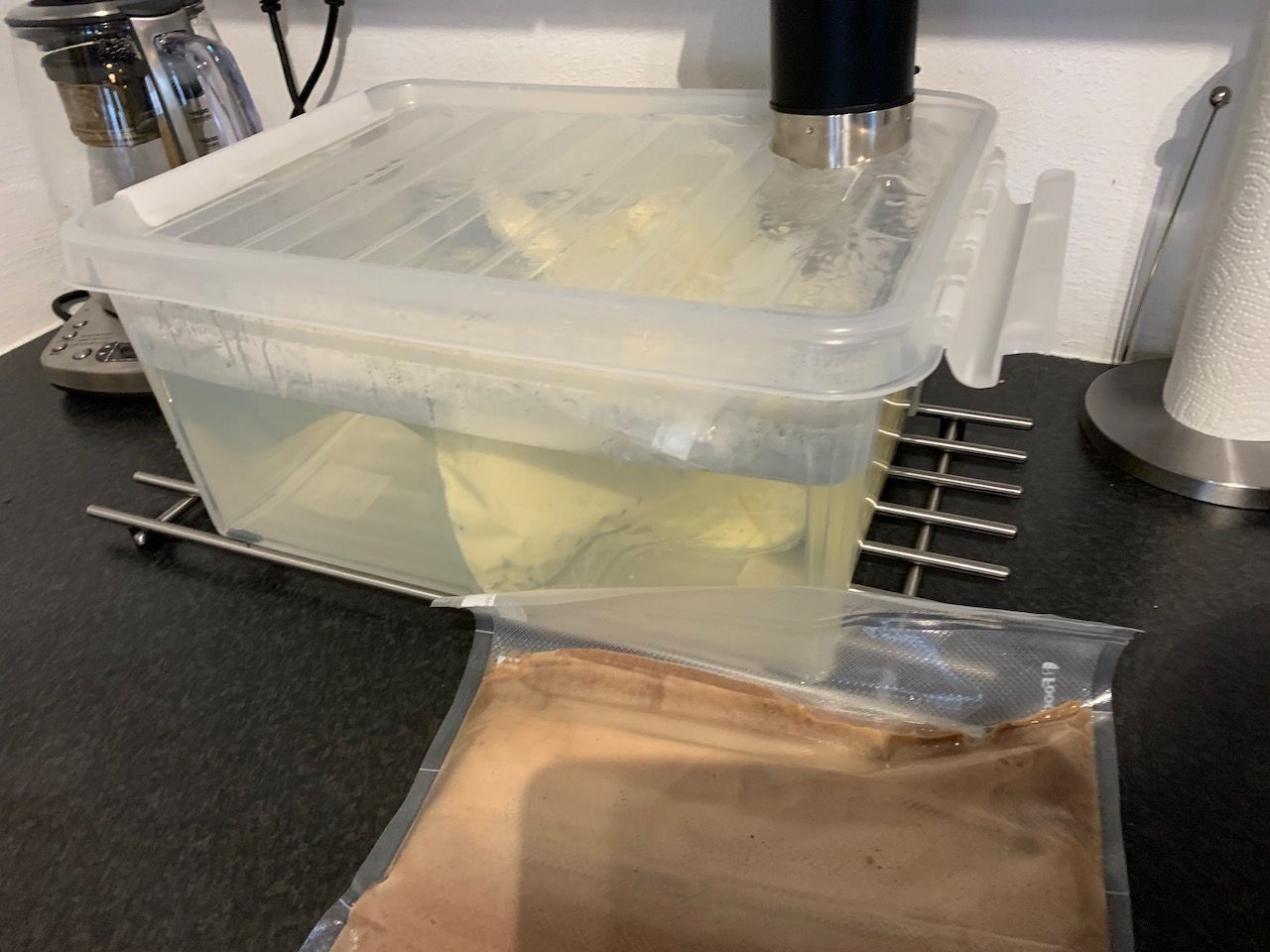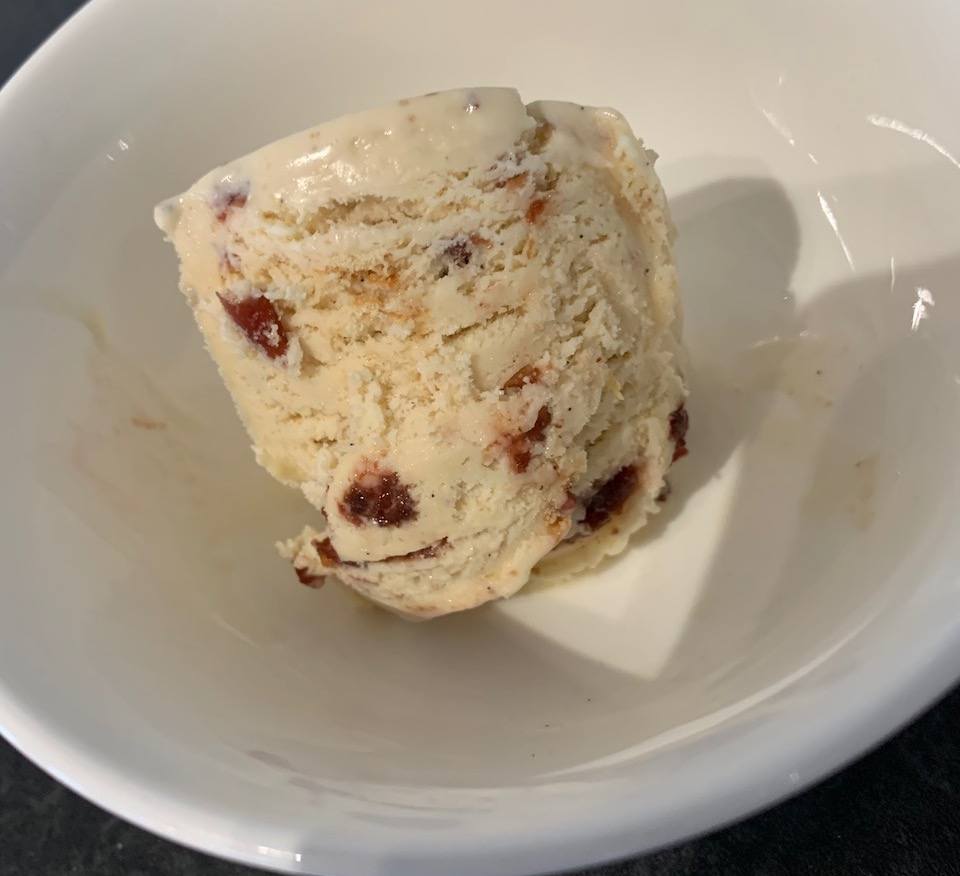Good ice cream requires a good base, but making such a base can be quite time-consuming. The base of many ice creams is a mixture of eggs, cream, and milk. This mixture needs to be heated to pasteurize and to improve the final texture of the ice cream1.
Traditionally, heating the mixture is done on the stovetop, as this has the added benefit that some of the moisture evaporates. However, this method is not precise and requires careful watching of the temperature. With sous vide, we can alleviate this and fully-automatic heat our ice cream mixture. Why I use sous vide for my ice cream base:
- No chance of burning the base or curdling the egg yolks;
- No need to monitor the ice cream base while heating;
- It’s easy to make large quantities;
- Heating the mixture in sous vide bags means you can easily cool and store them afterwards.
In this post, we’ll show how to use sous vide to make an ice cream base. As an example, we will create an Amarena Cantuccini ice cream based on a vanilla base. If you leave out the mixins, you end up with a normal vanilla ice cream.
Recipe for sous vide Amarena Cantuccini ice cream
Ingredients
These ingredients result in around 800ml of ice cream and is roughly the quantity needed for a single run of most ice cream machines. For the vanilla base mixture:
- 480 grams double cream (36% fat)
- 57 grams whole milk (3.6% fat)
- 65 grams skim milk powder
- 128 grams sugar
- 67 grams egg yolks
- 1 vanilla pod
- 1 teaspoon vanilla extract
If making the Amarena Cantuccini variant:
- Amarena cherries, halved
- Cantuccini (almond cookies), chopped
Equipment
- Emersion circulator. I use an Anova, but any brand will do.
- Vacuum pouches + sealer. I use a fairly cheap vacuum sealer from Foodsaver.
- Waterbath, can be a large pan or plastic container.
- Ice cream churner, I use a Smart Scoop from Breville. Available as the Sage Smart Scoop in Europe.

Multiple bags of ice cream mixture in a sous vide container. As heating in a water bath is consistent, you can make large batches at a time.
Steps
- Heat the water bath, set the circulator to 72 °C.
- Remove the seeds from the vanilla pod. Cut the pod itself in small pieces or process using a food processor.
- Combine sugar and eggs.
- Add milk and cream to egg mixture.
- Add milk powder. Mix well.
- Transfer the mixture to a vacuum bag. Add vanilla seeds and pod to the bag.
- Seal the bag and add it to the water bath.
- Heat the mixture for 30 minutes at 72 °C.
- Remove the bag from the water bath and transfer to a bowl with ice water. Cool the mixture as fast as possible. You can also cool the bag under running water in the sink.
- Store the mixture in the bag in the fridge overnight.
- The next day, sieve the mixture and discard pieces of the vanilla pod.
- Add one tablespoon of the vanilla extract by taste.
- Churn the ice cream according to the instructions of your ice cream machine.
- In the meantime that the ice cream is churning, cut the cherries in half. Roughly chop the Cantuccini cookies.
- Add the mixins in the final stage of churning.
- After churning, quickly transfer the ice cream to a pre-cooled storage container. Let the ice cream harden in the freezer, this takes roughly 3 hours.
Note on adjusting recipes for sous vide
Not every recipe for an ice cream base can be made sous vide. For ice cream, the distribution between water and (milk) solids in the final mixture is very important for the end result. Traditional recipes, which heat the base on the stove, account for water evaporation. In those recipes, higher water content is used so that after heating, the distribution is correct. When heating the mixture sous vide you won’t lose any water, so the initial water content needs to be reduced. This reduction can be done by increasing the amount of cream or milk powder in the recipe.

Amarena Cantuccini ice cream after freezing
Further reading
Interested in why heating the mixture improves texture? Ruben from Ice Cream Science has a great write-up in his post on vanilla ice cream. ↩︎


Jakob on